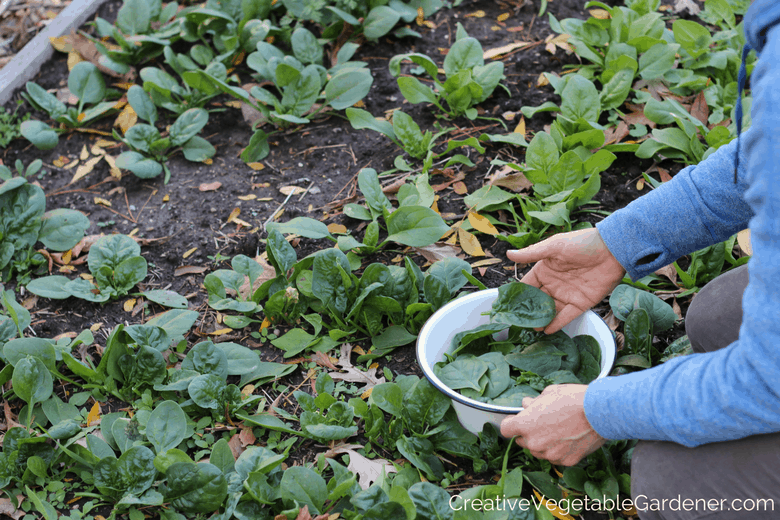
Did you know that fall spinach is a gateway vegetable?
Well, at least according to me.
Fall spinach is the vegetable that first got me hooked on cold weather gardening.
The first season I planted it for fall growing I got lots of big, delicious harvests throughout September, October, and November. I was pretty pleased.
Then it got cold over the winter (okay, that’s an understatement, I do live in Wisconsin) and the spinach was covered in snow and I forgot all about it.
Then, in spring, when the ground started to thaw and the sun returned and started getting me in the gardening mood, I went out to my garden to do a little clean up. Imagine my surprise when I realized that not only was the fall spinach from the previous year still alive, it was actually growing again.
It totally blew my mind.
I had no idea a vegetable in my garden could survive the harsh winter of Wisconsin (something I can barely manage to do myself!).
Thus began my love affair with the toughest vegetable I know – fall spinach.
This is a very different vegetable than the persnickety one known as spring spinach. That plant can barely produce more than one harvest during the spring months before going to seed. It’s barely worth planting.
But, fall planted spinach, be still my heart! One planting can provide as many as eight months worth of spinach harvests.
Take that, you delicate spring planted spinach.
Let me use some photos from my garden to illustrate why you, too, should fall in love with planting spinach in fall. Then we’ll get into the specifics of how, when and what varieties to plant.
Fall Spinach: Why It’s the Most Amazing Vegetable to Grow
Here’s a season in the life of fall planted spinach as an illustration of why you must plant it in your garden this year.
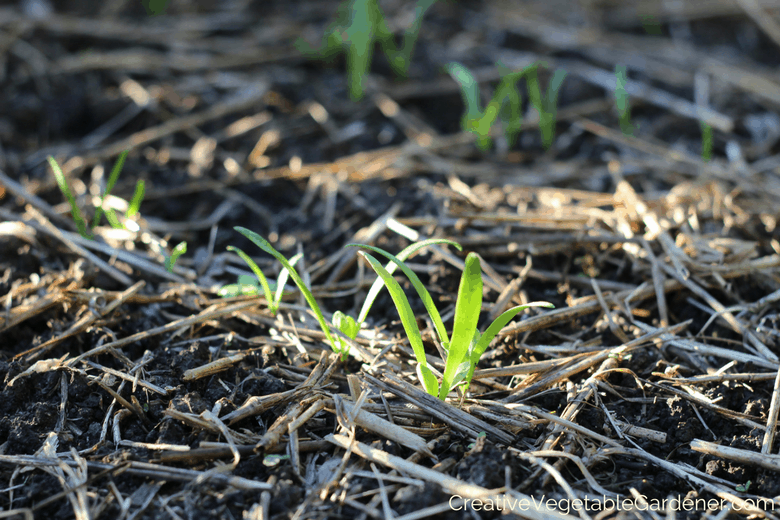
August 22: I usually plant around August 15 depending on the weather. We’ll talk more about timing later in the article. One of the beds of fall spinach I planted about a week before is germinating nicely!
.

September 14: I’ve already begun harvesting fresh salads for dinner from this planting.
.
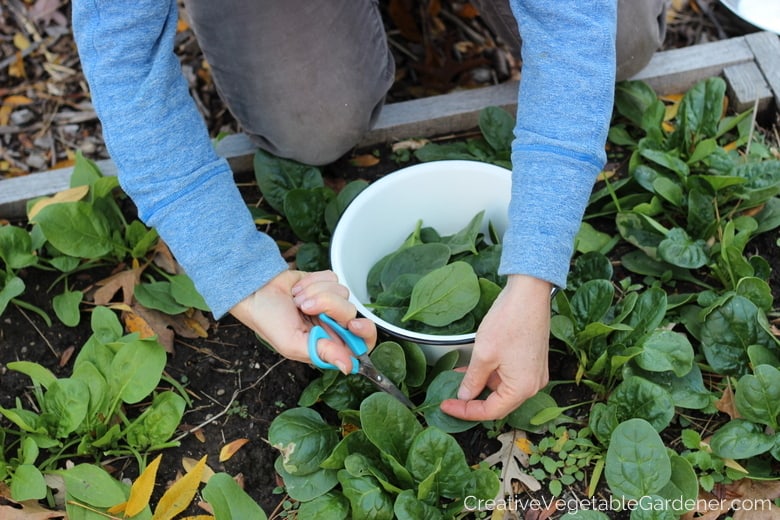
October 31: I’m still harvesting from my fall plantings. Sometimes I have more than I can use, so I pack it raw into freezer bags to use in my morning smoothies during winter.
.
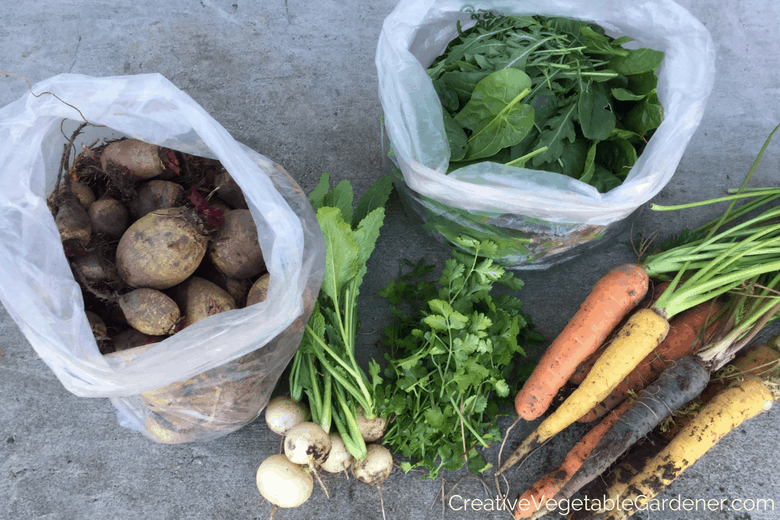
November 21: This impressive harvest of fall garden vegetables is getting packed into a cooler and taken to my in-laws for Thanksgiving dinner. Of course, we have to serve a spinach salad!
Here are the easiest vegetables to plant in autumn.
.

December 8: It’s starting to get cold here in Wisconsin, so my spinach is freezing at night, but if the temps get above 32 degrees F and the leaves defrost I can harvest it for a salad that night.
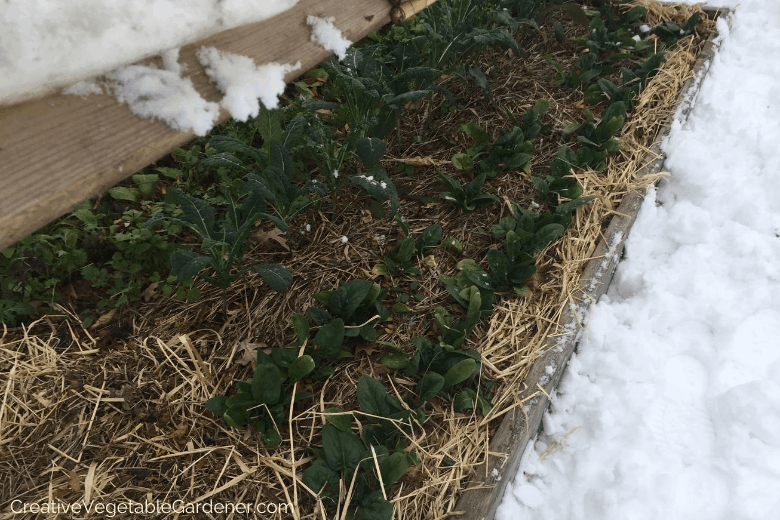
Spinach can survive the winter in zone 5 with no protection. But, during some years I choose to add a low tunnel made of greenhouse plastic on top of my spinach. This keeps it warmer during the day and increases the chances it will defrost when it’s sunny out.
I’ve also noticed that when I cover my spinach for the winter it bounces back and starts growing much earlier in the early spring.
.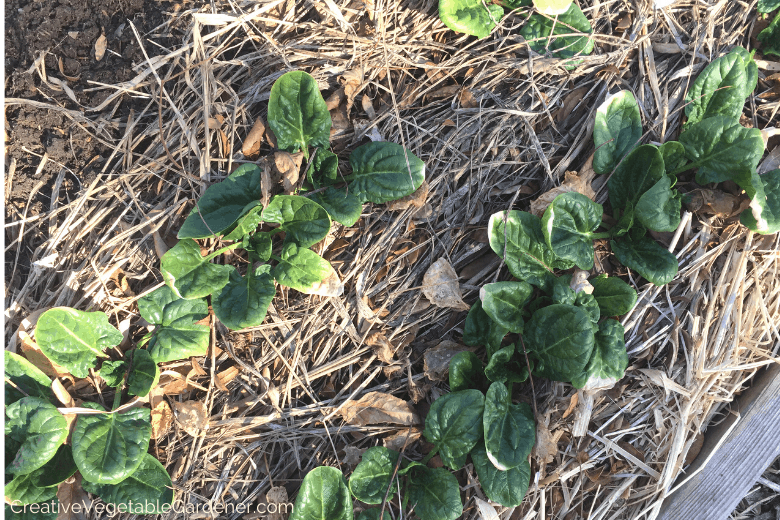
Mid-December – March: Where I live in Wisconsin plant growth stops during this time which means the spinach isn’t growing anymore. I often try to save my last harvest for Christmas dinner. After that I let the bed rest for January and February.
February 19: The above photo is what the spinach bed looks like on this date. It’s starting to wake up as the days get longer. In one very mild year I was able to harvest in February. Usually it’s not until March when I get my first spinach harvest.
Remember, this is the same spinach that was planted the previous August!

March 24: By this time the spinach has started to grow again and I’ve likely harvested from it a few times. This particular year we got a late snowstorm that covered the spinach, but it was fine. The snow defrosted quickly and I resumed my harvesting schedule.
.
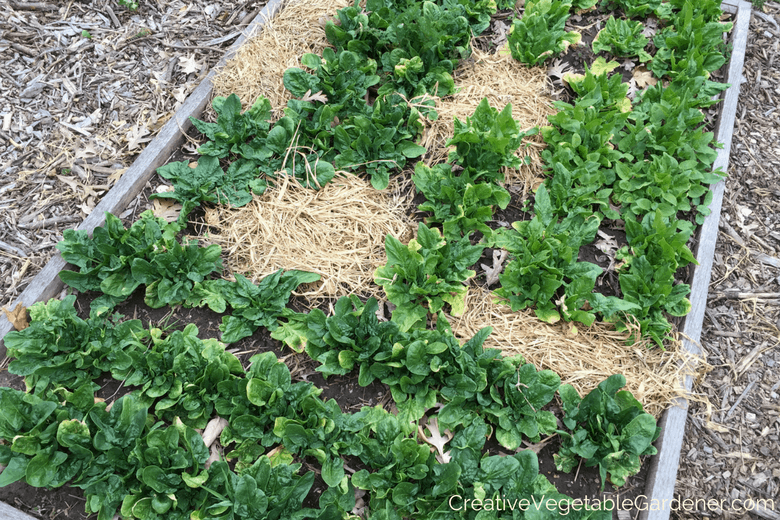
April 20: That same snow-covered bed from the previous photos is growing quickly now that it’s warming up. I’m starting to have more spinach than I can eat. It’s time to put some bags together for the neighbors!
.
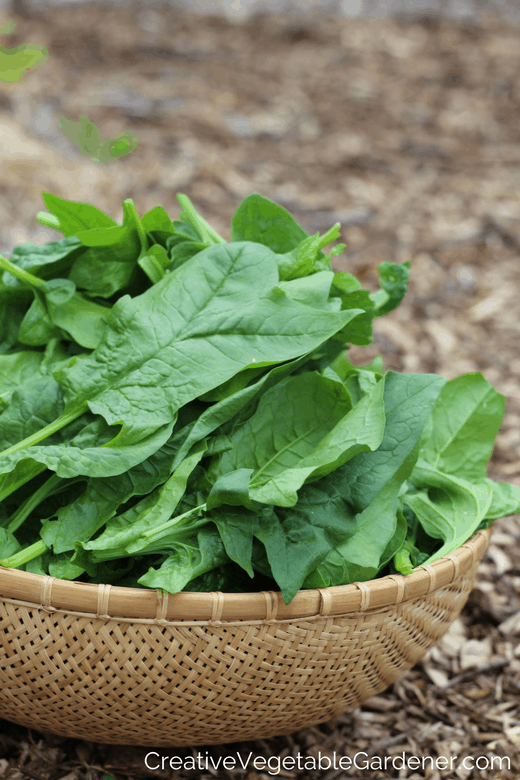
May 12: I’m still harvesting from last August’s planting. That’s over eight months of spinach harvests from the same garden bed. Every year I’m giddy with amazement that this really works!
To review – I plant in August and harvest from that planting from September-December. Once in awhile I’m able to harvest in February. And every year I harvest in March-May. That’s between 7-8 months of harvests from one fall spinach planting!
Sometime in May, the spinach starts to bolt due to the increasing daylight and warm spring temperatures. I also seed some new spinach in April, but honestly, it just doesn’t compare. It also bolts by June, and at that point, I’ve only harvested from it two or three times.
That’s why it’s way more worth it to plant fall spinach. It lasts SO much longer than spring planted spinach.
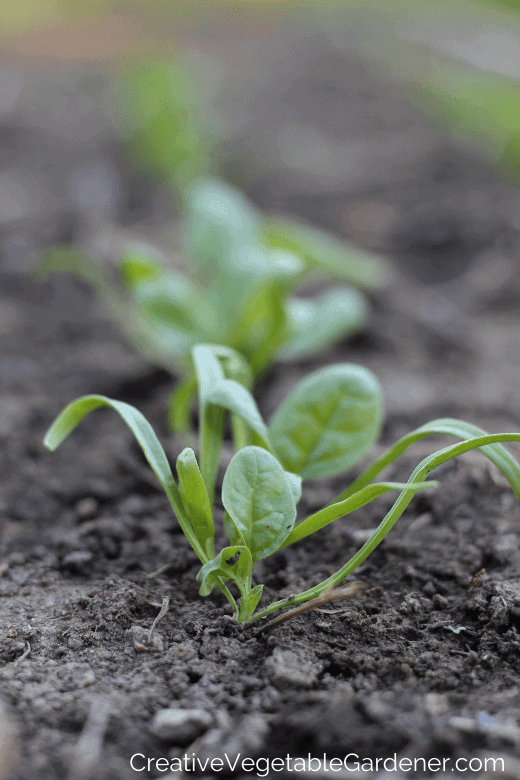
Planting Spinach in Fall
Hopefully you were convinced by the photos from my garden above to try your hand at planting spinach in fall. Here’s how to go about it.
Step 1: Know your first frost date.
Figure out your average first frost date. If you’re not sure when it is, you can go to this website and type in your zip code. It will give you a range for your average first frost. You can pick a date somewhere in the middle of that range.
Step 2: Plan your planting schedule.
Spinach can be planted 6-8 weeks before your average first frost. Count back from your average first frost date to six, seven and eight weeks before. This is your planting window.
I’ve had better luck planting spinach around eight weeks before my frost date. That’s about mid-August in my zone 5 garden. This also gives me a buffer for replanting if something goes awry.
That being said, climate change is altering things in my garden. Some years our Augusts have been hot and dry and I’ve had trouble getting my spinach to germinate. If it’s very hot around the time you’re planting spinach try planting in a partially shady garden bed, covering the bed with shade cloth to keep the soil cooler, or pushing your planting back a week or two to see if the weather cools.
If this is your first time planting fall spinach you could consider planting a few rows at eight weeks before your frost and another few rows six weeks before. This would allow you to compare to see which timing is better for your garden.
Make sure you’re keeping track of planting dates somewhere (I suggest a garden map) so you can figure out the best planting dates over time.
And remember, plant growth slows down in the fall, so the earlier you plant (within reason) the bigger the leaves will grow.
Step 3: Plant
My biggest tip for fall planting is to slightly over-seed since you don’t have much time for do-overs! You can always thin the plants out later. In my 4′ wide raised beds I usually plant five rows down the length of the bed.
I share recommended varieties at the end of the article.

Step 5: Water!
The most important factor in your success is to keep the garden soil moist! In many gardens it’s very dry during summer when you’re planting fall vegetables. Make sure you’re watering your newly seeded garden bed 1-2 times a day (morning and evening) until germination.
Step 6: Spinach care after germination
Water: Once the seeds germinate put them on a 1 inch per week watering schedule (more if you live in a very hot area or have sandy soil). Most vegetables like this amount of water per week. If it rains an inch you don’t have to water. If it’s dry you should take your hose out and soak the bed.
Get my best tips for watering your vegetable garden.
Thin: If you over-seeded your bed like I suggested above and you have a lot of plants growing close together they won’t grow very big if they’re overcrowded.
When the plants are a couple of inches tall you can go back and thin the rows. The recommended spacing for spinach about one inch between plants. To achieve this you’ll need to pluck out or cut off at the soil level every plant that isn’t one inch from the one next to it.
I have a small measuring tape I use for just this purpose.
I know thinning can be painful for many gardeners! But, you’re going to get a much better spinach harvest if you do it.
Thinning is especially critical in the fall when plant growth is slowing down. You want the spinach plants to have plenty of space so they grow as quickly as possible.
Mulch: After thinning your spinach you should then put a layer of mulch between each row to keep the garden bed weed-free and trap in soil moisture. I highly recommend keeping your entire garden mulched at all times, unless you’re waiting for seeds to germinate.
Read more about vegetable garden mulch and why mulch is the ultimate garden tool.
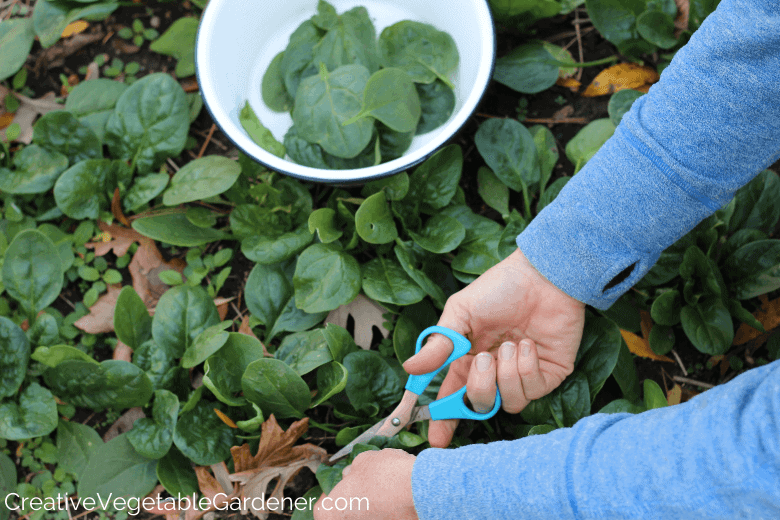
Step 7: Harvest
Spinach is usually at harvest size about 40 days after planting, depending on what variety you plant and the conditions in your garden.
But, plant growth slows down in the fall as the days get shorter, so conventional wisdom says add about a week to this number.
The great thing about spinach is that you simply remove the biggest leaves from each plant with garden scissors or pruners and leave the rest to grow bigger.
In my garden I can usually harvest spinach until at least Thanksgiving and sometimes until Christmas. It just depends how much you have out in the garden and how heavily you’ve been harvesting it.
Depending on where you live it will stop growing when the day length drops below nine hours. (The first week in November where I live.) This means eventually you’ll run out of spinach to harvest since it’s not growing anymore. I like to leave a few leaves on each plant to give it a growing jumpstart in late winter.
Step 8: Let it hang out in the garden
You’ve already learned that spinach can survive the winter in colder climates like mine in Wisconsin where it often drops to below zero degrees F for several days at various times throughout the winter.
So, you don’t have to worry about the increasingly colder temperatures as fall heads into winter.
One thing to note, though, is that once the daytime temperatures stay below 32 degrees F the spinach will remain frozen until the weather goes above that temperature and it can thaw out.
This is only a problem if you want to eat your spinach in a fresh salad. You’ll need to wait until a sunny, warm day for it to defrost.
If you don’t care if the spinach leaves are frozen when you harvest – because you’re going to use them in a smoothie or soup – then go ahead and pick frozen leaves.
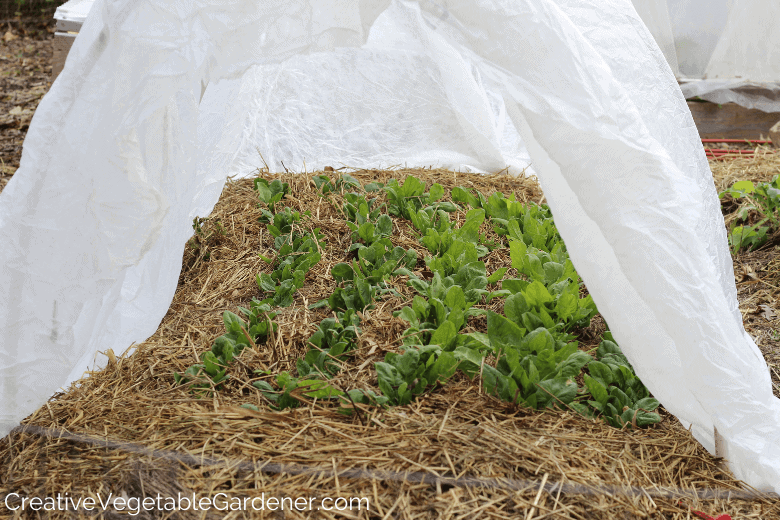
Step 9: Cover spinach beds
You do not have to cover your spinach beds for them to survive the winter. There have been many years when I’ve just left them out to fend for themselves. But, I have found that covering the spinach protects it from some of the worst of the winter winds and drying out.
And, I’ve noticed that spinach covered with one of the below options bounces back more quickly in the spring and starts growing earlier.
Here are some options:
Mulch: When you’re finished harvesting your spinach for the season (for me that’s usually sometime in December) you can cover the entire bed with a thick layer of mulch to protect the plants. But, make sure you remove it in late February to signal to the spinach that it’s time to start re-growing again. You can leave the mulch between the rows, just take it off from on top of the plants.
Row Cover: Another option is to cover the beds with row cover or frost cloth to trap in some extra heat. You can leave it on all winter for a layer of protection.
Cold Frame: Placing a cold frame on top of your spinach in mid- to late fall will help it warm up more quickly during the day when the temps are below 32 degrees F. This makes it easier to harvest for a longer period. And will warm up faster in the spring helping the spinach reactivate and grow.
Low Tunnel: These are similar to cold frames but are created using greenhouse plastic. I built one that functions like a lid so it’s easy to open and close.
I teach you exactly how to use frost cloth, low tunnels and cold frames in my class, Harvesting Fresh Veggies in the Snow: Planting a Cold Weather Garden.

What Varieties of Fall Spinach to Grow
One of the things I love about planting my own spinach is that I can pick out varieties that are more tasty than the kind you find at the grocery store.
There are actually three types of spinach: smooth leaf, semi-savoyed and savoyed.
The most common type of spinach you find at the grocery store, especially in the plastic packs, is smooth leaf. It has flatter and softer leaves.
Semi-savoyed and savoyed have a more crinkly texture and thicker leaves.
Personally, I prefer the savoyed varieties because they’re heartier and more substantial than the smooth leaf.
I purchase the majority of my seeds from Johnny’s Selected Seeds and High Mowing Seeds. All of the below varieties can be found there.
Here are some of my favorite varieties for growing spinach in fall.
Giant Winter Spinach: I find that this variety last the longest the next spring. It’s always the last to bolt. And wait until you see how big the leaves are!
Corvair: Dark green, rounded leaves, abundant growth
Verdil: Very cold tolerant
There are lots of different spinach varieties out there. Read through the descriptions online or in the seed catalog and experiment with a new one each year alongside your tried and true varieties.
The only one I don’t recommend planting is Bloomsdale, which is one of the most common. I find that it bolts very early the next year.
That’s the story of one little spinach planting! Have I convinced you why fall-planted spinach is the best vegetable ever? Whew. I’m glad. That means you’re going to get out there and plant some this season, right?

Additional Resources for Fall Gardening
MASTERCLASS: Harvesting Fresh Veggies in the Snow. The key to having more fresh food right outside your door for more months of the year is to extend your garden season. And if you do it right, you can be harvesting delicious veggies for up to 10 months of the year, even if you live in a northern climate!
I live in Wisconsin, zone 5a, and every year I harvest food from my garden during most months of the year -without a heated greenhouse or any other expensive additions to my garden. In 25 different videos and accompanying worksheets, checklists, and calendars, I distill my years of trial and error down to just the essentials you need to know to help you plant and harvest from a robust cold weather garden.
BLOG ARTICLES: Read more about how to have an awesome fall garden in these posts.
- 8 Easy Vegetables to Grow in Your Fall Garden
- How to Eat Beets From Your Garden All Year Round
- Why Growing a Fall Garden Is So Easy
SHARE IT ON PINTEREST







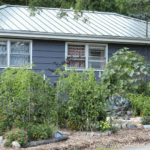
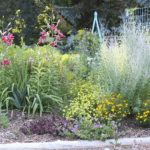
Comments
[…] my dinner most nights. Sometimes organic spinach costs up to $9/lb. in my area. So, I make sure to plant several beds with spinach in spring and fall to provide my own salads as many nights as […]
Do you cover the spine with hay or straw…..is there a different?
[…] from The Creative Gardener has some great ideas for harvesting spinach all winter long – even under […]
[…] Plant Now for Spinach Next Spring […]
[…] Spinach is one of the only vegetables that can survive the harsh winter in Wisconsin with no protection. And, it will start to grow again in the lengthening days of the following March […]
[…] Fall Spinach: Why It's the Most Amazing Vegetable to Grow […]
[…] It’s no secret that spinach is my favorite vegetable to grow in my garden. And this Giant Winter Spinach? It ain’t no joke. (Learn how to harvest spinach for over seven months of the year here.) […]
My spring spinach was completely devoured by rabbits and chipmunks, except they left the stems and just chewed the leaves off each side! I assumed it was going to die, and didn’t know (still don’t) how to keep the critters out, so I stopped tending the spinach bed, figuring it wasn’t worth my time since I didn’t get to harvest a single leaf. I just walked by the bed the other day and it’s growing again pretty thickly. Did my spinach survive and self-seed? If so, do I need to pull that out and put it in compost and plant new spinach seeds, or just let this grow and try to harvest from it? I’ve never grown spinach before and am clueless.
[…] planted spinach in late summer, now is the time to start harvesting it; you may still be able to plant some indoors or under winter […]
[…] Once the temperatures dip into the lower 20’s and teens F, most of the plants will eventually die without the added protection of row covers, cold frames, and low tunnels. But, spinach, the super vegetable, can survive the harsh winters of northern climates with no protection and will start growing again in spring. (Read all about that here.) […]
Interesting! I never really thought about attempting to overwinter spinach. I thought it’d just turn to mush. Do you have a particular variety you like to plant?
I really like Giant Winter Spinach. It doesn’t bolt as quickly as other varieties the next spring I’ve found.
I love your blog, I learn something every time I read a post! Thanks for the great pictures and specifics about planting fall spinach. I’m going to try it this year.